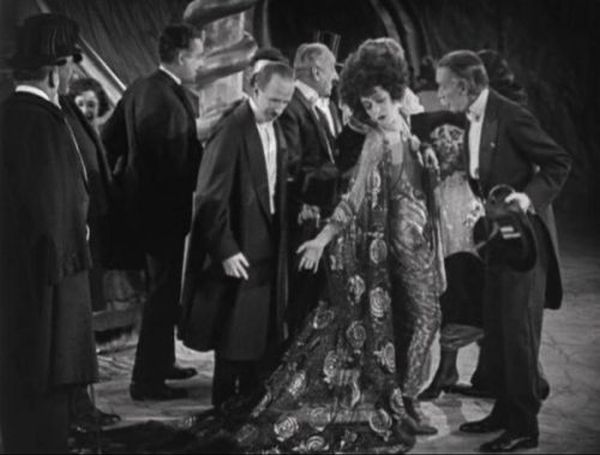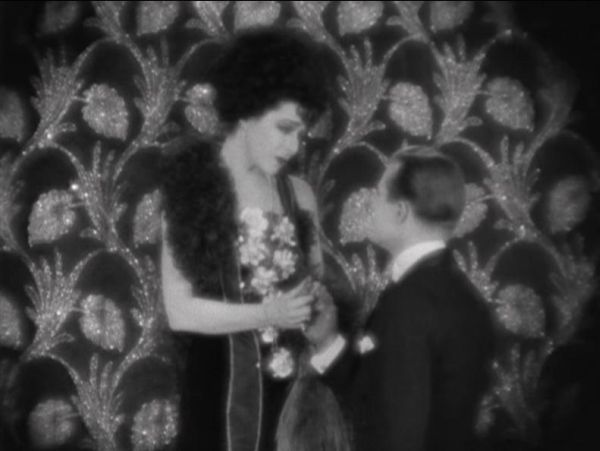“Camille” is ridiculous, melodramatic, unbelievable, silly, amazing, wonderful, beautiful, and mesmerizing. This 1921 film is a thin version of the Dumas classic, mildly modified for a modern audience, used only as a means to showcase glamour, style, and expression. I first heard about “Camille” when shahn at sixmartinis mentioned it a couple of years ago. Recently, D for Doom of Cult Movie Reviews recommended it for its art deco sets, also mentioning the silent could be found on the DVD for the Garbo-Taylor version. It’s a very nice print, too, surprisingly good for the year. There is also a Grapevine Video version, and while I haven’t seen it, those of us who want to avoid the Garbo version would probably rather have their video. Ahem.

While I have seen Nazimova in two of her 1940s supporting roles, “Camille” was the first silent Nazimova movie I’ve watched. It was an absolute revelation; I have never seen the camera love someone with such wholehearted abandon as it loved Alla Nazimova. Valentino is adored by the camera as well. He spends the full length of the film either staring straight ahead or flaring his nostrils and looking disgustingly gorgeous while doing so.
Infamous Parisian courtesan Marguerite and naive, rich young man Armand fall in love. She is ill and unhappy in her opulent but decadent life.

Armand takes her away. After a blissful spring together in the countryside, Armand’s father arrives to tell Marguerite that she cannot stay with his son, her past will ruin Armand’s future. Marguerite realizes she must make Armand believe she has betrayed him so he will move on. When their paths cross in Paris months later, Armand is cruel to the woman he thinks cares nothing for him.

The cinematography may seem a little pedestrian, but compared to other films I’ve seen from the early 1920s, it was well done. They were not subtle about making parallels, as you can tell from the two screencaps above: The first is when Armand initially approaches Marguerite to declare his love, while the latter is Armand approaching her after her insincere betrayal.
I knew the ending — we all know the ending — and yet I cried my eyes out. There is something to be said about a movie that tells you directly that it is manipulating you, yet you still freely allow yourself to be manipulated.
And the sets. My gods, the sets. Marguerite’s Paris apartment is an art deco wonder. Those camellia flowers you see on the title card are used all over her apartment:

This is a large glass wall that separates the living area from the bedroom. I love how the lights look like bubbles floating about. In reality, the small circles are reflections from the hanging living room lights, and the big circles are the neon from her bedroom decorations showing through the curtain.

Stylized camellias everywhere. It’s beautiful but it’s also a reminder that she’s the lady of the camellias, the kept woman who has to maintain a certain aura about herself or the rich guys will lose interest.

The dining area is a large glass dome with flower-shaped lights around the archway. It’s snowing outside while they dine, and I couldn’t help but shiver while imagining the cold coming in through all that glass.
The club where Marguerite later runs into Armand again is pure early-20s European hedonism:

Natacha Rambova can be thanked for the amazing set design on “Camille.” Natacha is mostly known as a crazy woman, a rumored lesbian who was in a “lavender marriage” with Rudy and who nearly ruined his career. But experience has taught me that most of the women who “almost ruined” their famous male partners did no such thing, and that gossip about the sexuality of stars often trumps reality in the minds of fans, so I’m not inclined to blindly believe the hype about her. Maybe it’s 100% true, maybe it isn’t. All I know is that her art deco designs are vastly influential, iconic, and largely unknown nowadays.
“Camille” somehow ends up being entirely a Nazimova vehicle, which makes the ending very strange. The editing has Armand finding a part of Marguerite’s will stating that a book she was given by Armand should be returned to him after her death, yet she’s still alive and still holding the book. He never shows up to see her on her deathbed or after she’s passed. I suspect the part with the will was moved earlier so Nazimova could have the last scene of the film.
Dr. Macro’s page of “Camille” pictures and lobby cards. Not many, but they are all beautiful.






I knew you’d swoon over those sets!
I agree about Rambova. I think she was one of those women who got demonised because they were clearly talented and didn’t bother to hide it, and this aroused jealousy in less talented men in Tinsel Town. Incidentally she did the costumes as well for Camille, and did all the production design and costumes for the Nazimova Salome. And wrote the screenplay. She deserves to be remembered as one of Hollywood’s great visual geniuses.
Nazimova herself seems to have been regarded with a certain amount of jealousy also. She produced her own movies, and although she never took a credit for it she often wrote and directed them as well. And she’d directed on Broadway, at a time when Broadway directing was strictly a boys’ club. And she wasn’t inclined to hide her talent either. She and Rambova were friends, and they both got tagged as uppity women!
Wow, could this BE any more gorgeous?
I’ve never seen this flick, though as you imply, one can’t really be a fan of old movies and *not* know about it. Still, I had no idea–I’m going to have to seek it out now!
Thanks for this gorgeous start to a Monday morning!
I put “Salome” in my queue the second I finished with “Camille.” When I saw Rambova listed in the credits, I admit I assumed it was one of those actor-got-his-girlfriend-a-job deals. I felt pretty bad when I realized what REALLY went down, that Rambova and Rudy weren’t even together when “Camille” began filming, and I remembered how much Rambova was slammed. She’s played like an idiot in that Ken Russell film, sadly.
As much as I like Ken Russell (and I like him a lot) I was pretty disappointed by the treatment of Rambova in that movie as well.
I don’t know if there’s a decent biography of Rambova. I’d love to know more about her. I think I’ve recommended Gavin Lambert’s biography of Nazimova before, but if I haven’t I’ll just say it’s an absolute must-read if you’re fascinated by Hollywood in the 20s. She was as extraordinary as a woman as she was as a creative artist. Not just a larger-than-life figure, but much much larger than life!
This is QUITE a film, and for those who can’t get the DVD the Grapevine version is good and has one of their better compiled scores.
Nazimova was definitely – Unique. Even Basinger (who admires her) talks of her “Pumpkin head and gunboat feet”.
I want to plug one cast member who made an impression on me- Rex Cherryman who plays Gaston. It’s a small part but he nails it- the best Bored Sophisticate you could imagine. His film was minimal and sadly he died in 1928.
Eric, one of the first drafts of this posts had this sentence: “In this movie, I learned that Nazimova had huge feet.” But I didn’t get a good screencap of them so I deleted it, but yeah, her feet are huge. It’s terrific.
Thanks for the suggestion on the book, D. I will listen to every suggestion you make from now on. For reals. Please do not abuse this power.
There’s no point in having a power unless you can abuse it! ;-)
There is absolutely a good biography on Rambova, Michael Morris’ “Madam Valentino” on which I relied heavily in my writing about Rambova, viewable at http://artsmeme.com/?tag=natacha-rambova
Debra, thanks so much for that, I’ve just ordered a copy. I’ve been fascinated by Rambova for years.